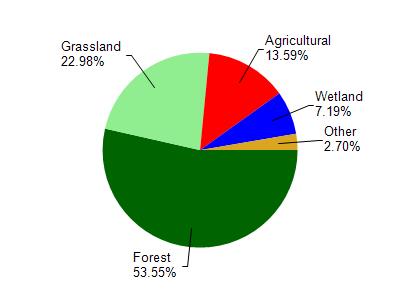Richland
No
No
No
Fish and Aquatic Life
Overview
Lower Lake is an oxbow lake located on the outlet of Garner Lake. Lower Lake enters directly into Knapp Creek. The lake is susceptible to flooding from the Wisconsin River. The lake supports a sport fishery made up of northern pike, large and smallmouth bass, walleye and panfish, although a high carp population keeps the lake water turbid. The lake is accessible through an inlet, and access by private land must be given with the landowners permission.
Date 2001
Author Aquatic Biologist
Historical Description
Source:1970, Surface Water Resources of Richland County,WI:WI-DNR Lower Lake: T8N, R2W, Sec. 7, 8
A drainage and seepage fed Wisconsin River oxbow lake located on the outlet of Garner Lake. The outlet from Lover Lake empties into Knapp Creek and is partially blocked by a beaver dam. The lake is subject to flooding by the Wisconsin River. Northern pike, large and smallmouth bass, walleyes and panfish provide a sport fishery. A high carp population keeps the lake turbid. Shallow marsh wetland surrounding the lake totals 247 acres and is prime habitat for muskrats# mink) beaver and waterfowl. Whitetail deer, waterfowl, and raccoon provide excellent hunting opportunities. The lake is accessible from the inlet and through private lands by permission.
Surface area = 24.8 acres, S.D.F. = 2.14, maximum depth = 6 ft.
Date 1970
Author Surface Water Inventory Of Wisconsin
Condition
Wisconsin has over 84,000 miles of streams, 15,000 lakes and milllions of acres of wetlands. Assessing the condition of this vast amount of water is challenging. The state's water monitoring program uses a media-based, cross-program approach to analyze water condition. An updated monitoring strategy (2015-2020) is now available. Compliance with Clean Water Act fishable, swimmable standards are located in the Executive Summary of Water Condition in 2018. See also the 'monitoring and projects' tab.
Reports
Management Goals
Wisconsin's Water Quality Standards provide qualitative and quantitative goals for waters that are protective of Fishable, Swimmable conditions [Learn more]. Waters that do not meet water quality standards are considered impaired and restoration actions are planned and carried out until the water is once again fishable and swimmable
Management goals can include creation or implementation of a Total Maximum Daily Load analysis, a Nine Key Element Plan, or other restoration work, education and outreach and more. If specific recommendations exist for this water, they will be displayed below online.
Monitoring
Monitoring the condition of a river, stream, or lake includes gathering physical, chemical, biological, and habitat data. Comprehensive studies often gather all these parameters in great detail, while lighter assessment events will involve sampling physical, chemical and biological data such as macroinvertebrates. Aquatic macroinvertebrates and fish communities integrate watershed or catchment condition, providing great insight into overall ecosystem health. Chemical and habitat parameters tell researchers more about human induced problems including contaminated runoff, point source dischargers, or habitat issues that foster or limit the potential of aquatic communities to thrive in a given area. Wisconsin's Water Monitoring Strategy was recenty updated.
Grants and Management Projects
| Project Name (Click for Details) | Year Started |
|---|
|
|
Monitoring Projects
| WBIC | Official Waterbody Name | Station ID | Station Name | Earliest Fieldwork Date | Latest Fieldwork Date | View Station | View Data |
|---|
| 1206800 | Lower Lake | 10005278 | Lower Lake | 8/6/1970 | 9/2/2016 | Map | Data |
|

Watershed Characteristics
Lower Lake is located in the Knapp Creek watershed which is 158.64 mi². Land use in the watershed is primarily forest (53.60%), grassland (23%) and a mix of agricultural (13.60%) and other uses (9.90%). This watershed has 395.31 stream miles, 126.86 lake acres and 6,498.05 wetland acres.
Nonpoint Source Characteristics
This watershed is ranked Medium for runoff impacts on streams, Not Ranked for runoff impacts on lakes and High for runoff impacts on groundwater and therefore has an overall rank of High. This value can be used in ranking the watershed or individual waterbodies for grant funding under state and county programs.However, all waters are affected by diffuse pollutant sources regardless of initial water quality. Applications for specific runoff projects under state or county grant programs may be pursued. For more information, go to surface water program grants.